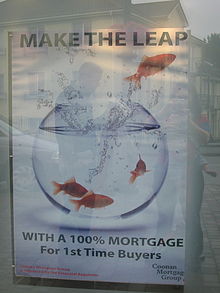Irish property bubble
The Irish property bubble was the speculative excess element of a long-term price increase of real estate in the Republic of Ireland from the early 2000s to 2007, a period known as the later part of the Celtic Tiger.
[6] The collapse of the Irish property bubble has had a lasting effect on the political, economic, social and financial landscape of Ireland.
While early negative effects such as ghost estates and high unemployment have been largely resolved, the residual collapse of the Irish banking and construction sectors has contributed to a countrywide housing crisis that persists as of 2020.
[9] The pace of expansion in lending to households from 2003 to 2007 was among the highest in the Eurozone,[10] with German banks having US$208.3 billion in total exposure to Ireland.
[18] One author described the "Breakfast Roll Men"—named after the popular convenience food construction workers often ate—as "the pumping heart of the economy".
[19] Interest rates set by the European Central Bank (ECB) are only guided by low inflation targets in the Eurozone.
Some[20] felt this was, and is, too narrow an objective, leading to decisions on interest rates that are inappropriate, e.g. for states with record levels of employment, rising house prices, and consumer spending.
The pace of credit expansion to finance the Irish housing bubble accelerated sharply in the years preceding the crisis.
[23] The CBOI continually ignored warnings from the Ireland-based Economic and Social Research Institute (ESRI) about the dangerous scale of bank loans to property speculators and developers.
The official did admit that the Central Bank had failed to give sufficient warning about reckless lending to property developers.
[30] A report by the Oireachtas Public Accounts Committee said it was "exercising inadequate supervision" and a proper analysis of loan books of the banks was not done.
"[33] The CBOI had the government put contingency plans in place to provide armed Defence Force security for major Irish banks over fears of public disorder should a cash shortage be triggered at the height of the financial crisis.
[34] The reckless lending practices of banks cost taxpayers €64 billion or €16,000 for every man, woman and child living in the Republic of Ireland.
[citation needed] Improvements in the technical education area also played a key role in upgrading the skills of the Irish workforce.
[36] The combination of high education standards and capitalisation ratios in investment projects resulted in considerable improvements in labour productivity for the economy as a whole.
Over time, the scale of residential mortgage debt reached a proportion that greatly concerned the Irish government because of its effects on the Republic's economy.
This became of increasing concern to the Irish Central Bank, which had issued many warnings in an effort to affect consumer behaviour,[40] but which signally failed to use any micro-economic tools such as prudential limits on lending or deposit requirements.
This happened on a substantial scale in the Greater Dublin area in counties Wicklow, Kildare, Meath, Louth, and Carlow.
[55] A research paper by UCD Professor Morgan Kelly, published by the ESRI alongside the Quarterly Economic Commentary, suggested that the "same people who told us we would have a soft landing are saying we will crawl out ... we have bottomed out.
[56][57] These reports were met with hostility by the political establishment; on 4 July 2007, Taoiseach Bertie Ahern stated at a conference in Donegal that he did not understand why people sitting on the sidelines, "cribbing and moaning" about the economy, did not commit suicide.
By June 2009, it was reported that around 40% of the price escalation that had occurred during the property bubble years ("Celtic Tiger Part 2") of 2001–2007 had been lost.

